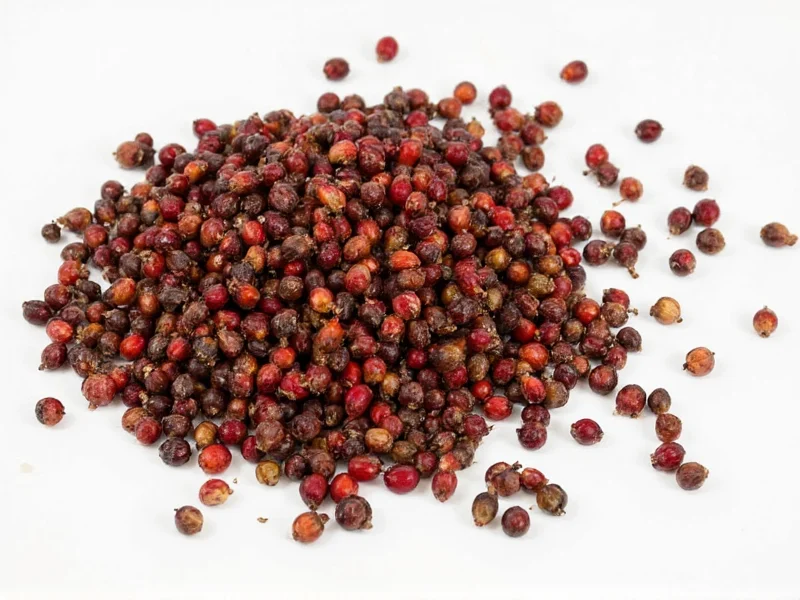Understanding Peppercorn Shelf Life
Peppercorns, whether black, white, green, or pink, are dried berries from the Piper nigrum plant. Their longevity depends primarily on whether they're whole or ground. Whole peppercorns have a protective outer layer that preserves their essential oils and piperine (the compound responsible for pepper's heat and flavor).
Unlike perishable foods, dried spices like peppercorns don't spoil in a way that creates health hazards. However, they do gradually lose their aromatic compounds and flavor intensity. This degradation happens much slower with whole peppercorns compared to pre-ground versions.
Whole vs. Ground: Shelf Life Comparison
| Type | Pantry Shelf Life | Peak Flavor Duration | Signs of Degradation |
|---|---|---|---|
| Whole peppercorns | Indefinite (safe to eat) | 2-4 years | Faded aroma, diminished heat |
| Ground pepper | 2-3 years (safe) | 4-6 months | Very mild flavor, dusty appearance |
| Cracked peppercorns | 1-2 years (safe) | 6-12 months | Noticeable flavor loss |
How to Tell If Peppercorns Have Lost Quality
While peppercorns remain safe indefinitely when stored properly, several indicators show they've passed their prime:
- Aroma test: Fresh peppercorns should have a sharp, piney scent. If you need to crush them to detect any aroma, they've lost significant flavor
- Visual inspection: Look for mold (extremely rare in properly stored peppercorns), discoloration, or insect activity
- Taste test: The most reliable method – if your pepper lacks heat and complexity, it's time to replace it
- Texture changes: Peppercorns that have absorbed moisture may feel soft or sticky
Factors That Accelerate Flavor Loss
Several environmental factors dramatically reduce peppercorn shelf life:
- Light exposure: UV rays break down essential oils. Clear containers on spice racks reduce shelf life by 50% compared to opaque storage
- Air exposure: Oxygen causes oxidation of volatile compounds. Each time you open the container, you introduce moisture and oxygen
- Temperature fluctuations: Kitchen heat near stoves or ovens accelerates degradation
- Moisture: Humidity causes clumping and potential mold growth in ground pepper
Optimal Storage Methods for Maximum Longevity
Follow these evidence-based storage recommendations to preserve peppercorn quality:
- Choose whole over ground: Invest in a pepper mill and grind peppercorns fresh for maximum flavor impact in your dishes
- Use airtight containers: Glass jars with tight-sealing lids outperform plastic containers which can absorb odors
- Store in darkness: Keep peppercorns in a cabinet away from light sources rather than on open spice racks
- Maintain stable temperature: Avoid locations near stoves, dishwashers, or windows where temperatures fluctuate
- Consider refrigeration for humid climates: In areas with humidity above 60%, refrigeration can prevent moisture absorption (ensure container is completely airtight)
When to Discard Peppercorns
While safety concerns are minimal, discard peppercorns immediately if you notice:
- Visible mold growth (appears as fuzzy white or green spots)
- Signs of insect infestation (webs, larvae, or adult insects)
- Musty or off odors indicating moisture damage
- Clumping in ground pepper that doesn't break apart easily
For quality reasons, replace whole peppercorns after 4 years and ground pepper after 1 year, even if no obvious spoilage signs appear. The flavor compounds simply degrade beyond useful levels.
Maximizing Flavor in Your Cooking
To get the most from your peppercorns:
- Toast whole peppercorns in a dry pan for 1-2 minutes before grinding to release additional aromatic compounds
- Grind peppercorns immediately before use – pre-ground pepper loses 50% of its volatile compounds within 15 minutes
- Use a burr mill rather than a blade grinder for more consistent particle size and less heat generation
- Add pepper toward the end of cooking for maximum flavor impact in hot dishes
Common Questions About Peppercorn Longevity
Can old peppercorns make you sick?
No, properly stored dried peppercorns don't create harmful compounds as they age. They simply lose flavor and potency. The main risk comes from moisture exposure leading to mold growth, which would be visibly apparent before consumption.
Do different colored peppercorns have different shelf lives?
Black peppercorns (the most common variety) have the longest shelf life due to their thicker outer layer. White peppercorns (black peppercorns with the outer layer removed) degrade slightly faster. Green and pink peppercorns, often preserved differently, may have shorter shelf lives depending on processing methods.
Is it safe to use peppercorns past their 'best by' date?
Yes, the 'best by' date on peppercorn packaging indicates peak quality, not safety. Properly stored whole peppercorns remain safe indefinitely, though their flavor diminishes significantly after 2-4 years. Always inspect for mold or off odors before use.
Why does my pepper mill get clogged with old peppercorns?
Moisture absorption causes peppercorns to expand slightly, making them difficult to grind. Old peppercorns that have lost essential oils become more brittle and produce fine dust that gums up grinding mechanisms. Regular cleaning of your pepper mill and using fresh peppercorns prevents this issue.
Can I revive stale peppercorns?
Toasting whole peppercorns in a dry skillet for 1-2 minutes can temporarily enhance remaining flavors by releasing trapped essential oils. However, this only provides a marginal improvement for moderately stale peppercorns and won't restore completely degraded ones. The most effective solution is replacing old peppercorns with fresh ones.











 浙公网安备
33010002000092号
浙公网安备
33010002000092号 浙B2-20120091-4
浙B2-20120091-4